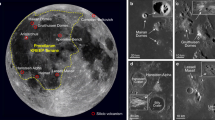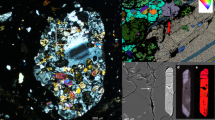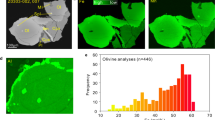Abstract
On Mars, clay minerals are widespread in terrains that date back to the Noachian period (4.1 billion to 3.7 billion years ago)1,2,3,4,5. It is thought that the Martian basaltic crust reacted with liquid water during this time to form hydrated clay minerals3,6. Here we propose, however, that a substantial proportion of these clays was formed when Mars’ primary crust reacted with a dense steam or supercritical atmosphere of water and carbon dioxide that was outgassed during magma ocean cooling7,8,9. We present experimental evidence that shows rapid clay formation under conditions that would have been present at the base of such an atmosphere and also deeper in the porous crust. Furthermore, we explore the fate of a primordial clay-rich layer with the help of a parameterized crustal evolution model; we find that the primordial clay is locally disrupted by impacts and buried by impact-ejected material and by erupted volcanic material, but that it survives as a mostly coherent layer at depth, with limited surface exposures. These exposures are similar to those observed in remotely sensed orbital data from Mars1,2,3,4,5. Our results can explain the present distribution of many clays on Mars, and the anomalously low density of the Martian crust in comparison with expectations.
This is a preview of subscription content, access via your institution
Access options
Access Nature and 54 other Nature Portfolio journals
Get Nature+, our best-value online-access subscription
$29.99 / 30 days
cancel any time
Subscribe to this journal
Receive 51 print issues and online access
$199.00 per year
only $3.90 per issue
Buy this article
- Purchase on Springer Link
- Instant access to full article PDF
Prices may be subject to local taxes which are calculated during checkout



Similar content being viewed by others
References
Bibring, J.-P. et al. Mars surface diversity as revealed by the OMEGA/Mars Express observations. Science 307, 1576–1581 (2005)
Mustard, J. F. et al. Hydrated silicate minerals on Mars observed by the Mars Reconnaissance Orbiter CRISM instrument. Nature 454, 305–309 (2008)
Ehlmann, B. L. et al. Subsurface water and clay mineral formation during the early history of Mars. Nature 479, 53–60 (2011)
Carter, J., Poulet, F., Bibring, J.-P., Mangold, N. & Murchie, S. Hydrous minerals on Mars as seen by the CRISM and OMEGA imaging spectrometers: updated global view. J. Geophys. Res. Planets 118, 831–858 (2013)
Sun, V. Z. & Milliken, R. E. Ancient and recent clay formation on Mars as revealed from a global survey of hydrous minerals in crater central peaks. J. Geophys. Res. Planets 120, 2293–2332 (2015)
Carter, J., Loizeau, D., Mangold, N., Poulet, F. & Bibring, J.-P. Widespread surface weathering on early Mars: a case for a warmer and wetter climate. Icarus 248, 373–382 (2015)
Elkins-Tanton, L. T. Linked magma ocean solidification and atmospheric growth for Earth and Mars. Earth Planet. Sci. Lett. 271, 181–191 (2008)
Abe, Y. Physical state of the very early Earth. Lithos 30, 223–235 (1993)
Lammer, H. et al. Outgassing history and escape of the Martian atmosphere and water inventory. Space Sci. Rev. 174, 113–154 (2013)
Dauphas, N. & Pourmand, A. Hf–W–Th evidence for rapid growth of Mars and its status as a planetary embryo. Nature 473, 489–492 (2011)
Borg, L. E., Nyquist, L. E., Wiesmann, H., Shih, C.-Y. & Reese, Y. The age of Dar al Gani 476 and the differentiation history of the martian meteorites inferred from their radiogenic isotopic systematics. Geochim. Cosmochim. Acta 67, 3519–3536 (2003)
Breuer, D. & Spohn, T. Early plate tectonics versus single-plate tectonics on Mars: evidence from magnetic field history and crust evolution. J. Geophys. Res. Planets 108, 5072 (2003)
Michalski, J. R. et al. Constraints on the crystal-chemistry of Fe/Mg-rich smectitic clays on Mars and links to global alteration trends. Earth Planet. Sci. Lett. 427, 215–225 (2015)
Chemtob, S. M. et al. Oxidative alteration of ferrous smectites: a formation pathway for Martian nontronite? Lunar Planet. Sci. Conf. XLVII, abstract 2520 (2017)
Wieczorek, M. A. et al. The crust of the Moon as seen by GRAIL. Science 339, 671–675 (2013)
Petford, N. Controls on primary porosity and permeability development in igneous rocks. Geol. Soc. Spec. Pub. 214, 93–107 (2003)
Clifford, S. M. A model for the hydrologic and climatic behavior of water on Mars. J. Geophys. Res. Planets 98, 10973–11016 (1993)
Marinova, M. M., Aharonson, O. & Asphaug, E. Mega-impact formation of the Mars hemispheric dichotomy. Nature 453, 1216–1219 (2008)
Kruijer, T. S. et al. The early differentiation of Mars inferred from Hf–W chronometry. Earth Planet. Sci. Lett. 474, 345–354 (2017)
Morbidelli, A., Marchi, S., Bottke, W. F. & Kring, D. A. A sawtooth-like timeline for the first billion years of lunar bombardment. Earth Planet. Sci. Lett. 355, 144–151 (2012)
Bottke, W. F. & Andrews-Hanna, J. C. A post-accretionary lull in large impacts on early Mars. Nat. Geosci. 10, 344–348 (2017)
Bish, D. L. et al. X-ray diffraction results from Mars science laboratory: mineralogy of rocknest at Gale Crater. Science 341, 1238932 (2013)
McCubbin, F. M. et al. Geologic history of Martian regolith breccia Northwest Africa 7034: evidence for hydrothermal activity and lithologic diversity in the Martian crust. J. Geophys. Res. Planets 121, 2120–2149 (2016)
Cannon, K. M., Mustard, J. F. & Agee, C. B. Evidence for a widespread basaltic breccia component in the martian low-albedo regions from the reflectance spectrum of Northwest Africa 7034. Icarus 252, 150–153 (2015)
Viviano-Beck, C. E., Murchie, S. L., Beck, A. W. & Dohm, J. M. Compositional and structural constraints on the geologic history of eastern Tharsis Rise, Mars. Icarus 284, 43–58 (2017)
Tornabene, L. L. et al. An impact origin for hydrated silicates on Mars: a synthesis. J. Geophys. Res. Planets 118, 994–1012 (2013)
Meunier, A. et al. Magmatic precipitation as a possible origin of Noachian clays on Mars. Nat. Geosci. 5, 739–743 (2012)
Wordsworth, R. D., Kerber, K., Pierrehumbert, R. T., Forget, F. & Head, J. W. Comparison of “warm and wet” and “cold and icy” scenarios for early Mars in a 3-D climate model. J. Geophys. Res. Planets 120, 1201–1219 (2015)
Mustard, J. F. in Volatiles in the Martian Crust (Elsevier, 2017)
Baratoux, D. et al. Petrological constraints on the density of the Martian crust. J. Geophys. Res. Planets 119, 1707–1727 (2014)
Agee, C. B. et al. Unique meteorite from early Amazonian Mars: water-rich basaltic breccia Northwest Africa 7034. Science 339, 780–785 (2013)
Pieters, C. M. Strength of mineral absorption features in the transmitted component of near-infrared reflected light: first results from RELAB. J. Geophys. Res. 88, 9534–9544 (1983)
Clark, R. N ., Swayze, G. A ., Gallagher, A ., King, T. V. V. & Calvin, W. M. The USGS digital spectral library 93–592 (US Geol. Surv. Open File Rep., 1993)
Hartmann, W. K. Martian cratering 8: isochron refinement and the chronology of Mars. Icarus 174, 294–320 (2005)
Robbins, S. J., Hynek, B. M., Lillis, R. J. & Bottke, W. F. Large impact crater histories of Mars: the effect of different model crater age techniques. Icarus 225, 173–184 (2013)
Croft, S. K. The scaling of complex craters. J. Geophys. Res. Solid Earth 90, C828–C842 (1985)
Garvin, J. B., Sakimoto, S. E., Frawley, J. J. & Schnetzler, C. North polar region craterforms on Mars: geometric characteristics from the Mars orbiter laser altimeter. Icarus 144, 329–352 (2000)
Abramov, O., Wong, S. M. & Kring, D. A. Differential melt scaling for oblique impacts on terrestrial planets. Icarus 218, 906–916 (2012)
Robbins, S. J. & Hynek, B. M. A new global database of Mars impact craters ≥1 km: 2. Global crater properties and regional variations of the simple-to-complex transition diameter. J. Geophys. Res. Planet. 117, E06001 (2012)
Morschhauser, A., Grott, M. & Breuer, D. Crustal recycling, mantle dehydration, and the thermal evolution of Mars. Icarus 212, 541–558 (2011)
Acknowledgements
Thanks to M. Rutherford, T. Hiroi and J. Bosenberg for assistance with experiments and instrumental measurements. Discussions with R. Milliken were helpful in identifying clay minerals in the altered samples.
Author information
Authors and Affiliations
Contributions
K.M.C. and S.W.P. conceived the study; K.M.C. undertook the alteration experiments and interpreted the results along with J.F.M.; K.M.C. developed the crustal evolution model and wrote the paper; all authors read the paper and contributed comments.
Corresponding author
Ethics declarations
Competing interests
The authors declare no competing financial interests.
Additional information
Reviewer Information Nature thanks F. McCubbin, L. Schaefer and the other anonymous reviewer(s) for their contribution to the peer review of this work.
Publisher's note: Springer Nature remains neutral with regard to jurisdictional claims in published maps and institutional affiliations.
Extended data figures and tables
Extended Data Figure 1 Elemental maps of basalt grain cross-sections.
Electron-probe microanalyser (EPMA) chemical maps, with silicon mapped as red, aluminium as green and calcium as blue. a, An unaltered sample, where plagioclase appears yellow, pyroxene is purple, olivine is red and glass is orange. b, A sample altered in the liquid field (325 °C, 300 bar), where a thick rind of altered material (arrows) is observed (blue phase, portlandite: a calcium hydroxide). c, A sample altered in the supercritical field with H2O only (425 °C, 300 bar). Alteration can be seen to extend into the interior of the grain (arrows).
Extended Data Figure 2 Model impact fluxes.
The blue dashed line represents a sawtooth LHB with a dynamic instability occurring at 4.1 Ga (ref. 20); the solid red line represents an accretionary tail bombardment. The accretionary tail curve was found by fitting an exponential function through the N50 ages of the five large basins from ref. 35, then scaling to reproduce the correct number of craters for our model grid size (see Methods). The LHB curve was modelled after that in ref. 20. Here, dC50/dt refers to the number of craters of diameter 50 km or more that are formed per time step over the model grid.
Extended Data Figure 3 Model result metrics for surface clay content.
The areal clay coverage represents the fraction of surface grid cells with more than 10% clay, assumed to be detectable by orbital remote sensing. The background clay content is the median clay content in surface grid cells located outside of detections. The dashed line at 3.4% areal clay coverage corresponds to the estimate in ref. 4. The light shaded region represents background clay contents of less than 1%, consistent with the lack of detectable clay in X-ray diffraction measurements from Gale crater soils22, and with the lack of clays in Martian regolith breccias23. The dark shaded region represents the confluence of these two constraints, such that model results within or near this region are more consistent with observed clay distributions on the Martian surface.
Rights and permissions
About this article
Cite this article
Cannon, K., Parman, S. & Mustard, J. Primordial clays on Mars formed beneath a steam or supercritical atmosphere. Nature 552, 88–91 (2017). https://doi.org/10.1038/nature24657
Received:
Accepted:
Published:
Issue Date:
DOI: https://doi.org/10.1038/nature24657
This article is cited by
-
Did Mars Possess a Dense Atmosphere During the First $\sim400$ Million Years?
Space Science Reviews (2021)
-
The Oldest Highlands of Mars May Be Massive Dust Fallout Deposits
Scientific Reports (2020)
-
Experimental and Simulation Efforts in the Astrobiological Exploration of Exooceans
Space Science Reviews (2020)
-
Geologic Constraints on Early Mars Climate
Space Science Reviews (2019)
-
Inventory of CO2 available for terraforming Mars
Nature Astronomy (2018)
Comments
By submitting a comment you agree to abide by our Terms and Community Guidelines. If you find something abusive or that does not comply with our terms or guidelines please flag it as inappropriate.



